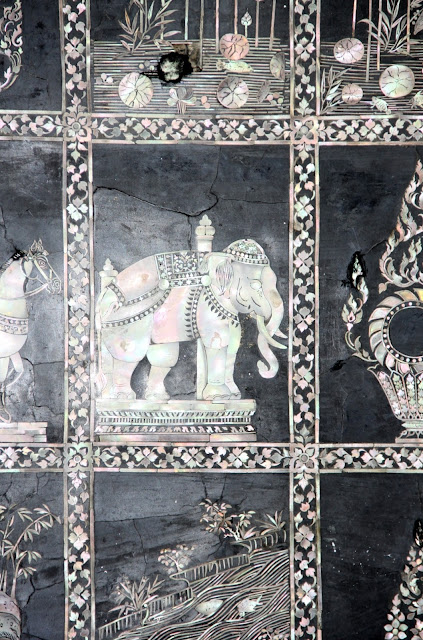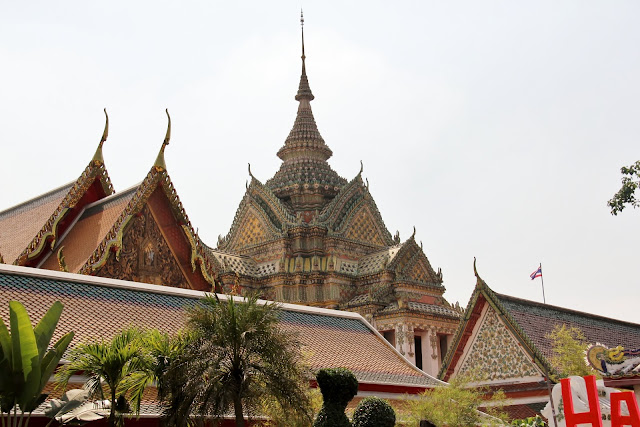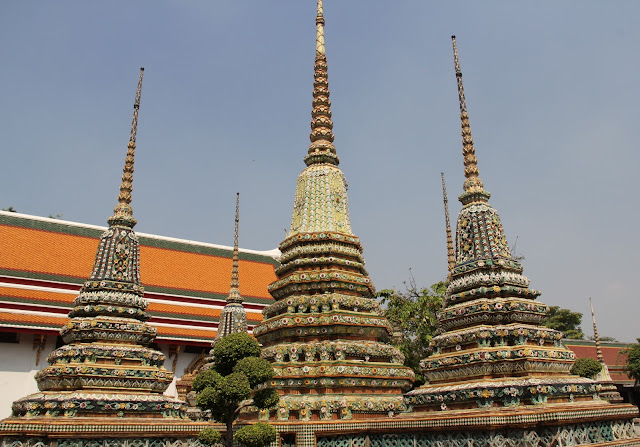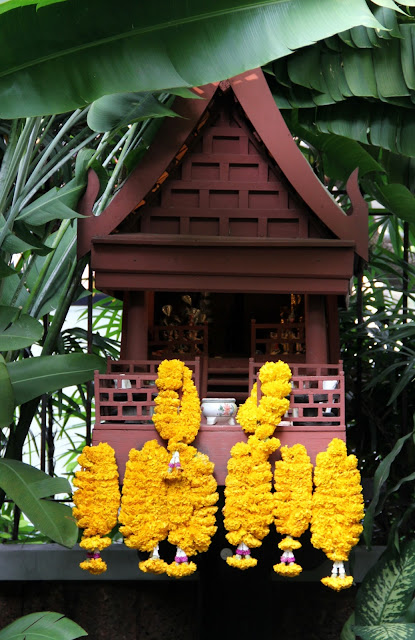We met our driver outside of the Grand Palace and he drove us to Wat Pho, which is literally right across the street. However, thanks to Bangkok traffic, it took us about 15 minutes to get there.
Wat Pho is named after a monastery in India where Buddha is believed to have lived. It is also known as the birthplace of traditional Thai massage. In addition to being one of the oldest and largest wats in Bangkok, Wat Pho's "claim to fame" is that it is home to the Reclining Buddha (housed in the building in the photo below).

The Reclining Buddha was built during the mid-19th-century and is brick covered with layers of plaster and gold. At 15 meters high and 43 meters long, the Reclining Buddha is one of the largest single Buddha images. The Reclining Buddha is as large as the Emerald Buddha is small and is quite an impressive sight.


The flower arrangement is made of water lotus flowers.
On our way out to walk around the complex, we passed a long line of bowls into which people were dropping coins.
Immediately outside of the structure housing the Reclining Buddha, there is a small garden which contains a bodhi tree propagated from the original tree in India where Buddha sat while awaiting enlightenment.

This altar & worship area were near the exit of the complex.
Next stop... the Jim Thompson House.
The Jim Thompson House is on every "what to see in Bangkok" list so I thought we should give it a go. Jim Thompson was a self-made American entrepreneur and the founder of the Jim Thompson Thai Silk Company. He first came to Asia as part of a military force that planned to liberate Thailand during World War II. He was assigned to Bangkok as a military intelligence officer attached to the O.S.S. (Office of Strategic Services - the predecessor organization of the CIA). After his retirement from the military, Thompson decided to return to Thailand and live there permanently. At the time, the craft of hand-weaving silk in Thailand was in a state of decline and Thompson devoted himself to reviving the craft and creating demand for fine quality hand-woven Thai silk products. He was a talented designer and textile colorist and made significant contributions to the revival of the industry and its subsequent growth during the 1950's and 1960's. He also worked to develop an international recognition and market for Thai silk products. In 2010, almost $23 Million of Thai silk was exported from Thailand, primarily to the U.S. (the largest market for Thai silk) and the U.K.
Jim, Jan and I had a nice lunch in the restaurant that is on-site and waited in the courtyard for our tour of the house and gardens to begin.
In the courtyard, this man was demonstrating how silk is spun.
Silk weaving is practiced in every region in Thailand but the Khorat Plateau, in the northeast region of Thailand, is the center of the silk industry in the country. Since I am not an expert on the spinning of Thai silk, I will rely on wikipedia for the following information The photos are by Jan though. The weaver had some baskets on display that contained the silk worms/silk at different stages during the growth/weaving process.
In addition to being credited for the revival of silk weaving in Thailand, Jim Thompson was known for the unique construction of his house (which we were about to tour). He combined six separate teak buildings - most of them at least 200 years old - to build a home that represented the best of traditional Thai architecture. After being purchased by Thompson, the homes were dismantled in their original locations (some were located hours from Bangkok) and then re-built on this site in downtown Bangkok. I found it interesting to learn that, according to Thai law, foreigners may purchase up to one rai (about 1/2 acre) of land for residential use if there is a reciprocal arrangement for Thai citizens in the buyer's home country or state. Fortunately for Thompson, his home state of Delaware met this requirement.
During the re-assembly/construction of his house and in order to maintain its authenticity, Thompson included characteristics of Thai architecture and followed practices of Thai construction. For example, to avoid flooding during the rainy season (especially important because the house was on the banks of a canal), the house was elevated a full story above the ground. The roof tiles were fired in the former capital of Thailand, Ayudhya and were done in a traditional Thai design. The red paint on the exterior walls is a preservative found on old Thai buildings. The chandeliers date back to the 18th and 19th centuries and were obtained from palaces in Bangkok. For practical reasons, the chandeliers have been modified for electricity. Construction of the home began in 1958 and Thompson moved into the home in the early part of 1959. His property was like an oasis in the middle of downtown Bangkok.
Looking out from the living room - across the canal - to the village where his weavers lived and worked. Living on and having the silk weaving done in close proximity to the canal provided Thompson with an easy means to transport his silk products in, out and around Bangkok.
A spirit house on the corner of the property.
And now, the great mystery of what happened to Jim Thompson...
Thompson disappeared on Easter Sunday, March 26, 1967 while on a hike in the Cameron Highlands in northern Malaysia. Thompson was in the area visiting friends and went out for an afternoon walk near the jungle, never to be seen or heard from again. There is great speculation over the reason for his disappearance...he was kidnapped by the Vietnamese for his involvement in spying activities (the Communist conspiracy), he was hit by a truck and buried in an unmarked grave or he was eaten by a tiger in the nearby jungle. Despite a massive search of the highlands and the jungle, Thompson vanished without a trace and not a single clue has ever turned up as to what really might have happened to him. His disappearance is one of the biggest unsolved mysteries in southeast Asia.
I can't write about his house, his art and his legacy to the Thai silk trade without posting a photograph of the man himself...
And, this is where we ended our day of playing tourist.
We were driven back to Nichada and spent the evening relaxing at home and getting ready for Jim and Jan's last day in Bangkok. I planned a very interesting activity for their last day but it required that we leave to go downtown at 6:15 am the next morning so an early night was essential!
Have a great Thursday!

The Reclining Buddha was built during the mid-19th-century and is brick covered with layers of plaster and gold. At 15 meters high and 43 meters long, the Reclining Buddha is one of the largest single Buddha images. The Reclining Buddha is as large as the Emerald Buddha is small and is quite an impressive sight.
The feet are 3 meters high and 4.5 meters long. The photo below gives you an idea of how big they are...
The bottoms of the Buddha's feet feature 108 panels inlaid with mother of pearl. Each panel shows one of the auspicious symbols by which Buddha can be identified.
In addition to the Reclining Buddha, there are over 1,000 other Buddha images in the Wat Pho complex. These photos were taken in the corridors surrounding the Reclining Buddha.

The flower arrangement is made of water lotus flowers.
(photo courtesy of Ssriram)
The line of people waiting to drop their coins was very long so we didn't stop and find out what the bowls were for. However, I have since learned that there are 108 bronze bowls (symbolizing the 108 auspicious characters of Buddha) and people drop coins in the bowls for good fortune and to help the monk maintain the wat.
The placement of the buildings at the Wat Pho complex was more orderly and spacious than at the Grand Palace. However, the colors of the painting and mosaics and the designs of the buildings were just as beautiful.
This must be a popular place for taking photos. Look who else had their picture taken in this same area during the Presidential visit to Thailand in December...
At the entrance to the Wat, there was a large display of photos, news articles and information about President Obama and Secretary Clinton visiting Wat Pho.
Mosaic detailing on the buildings...

The Jim Thompson House is on every "what to see in Bangkok" list so I thought we should give it a go. Jim Thompson was a self-made American entrepreneur and the founder of the Jim Thompson Thai Silk Company. He first came to Asia as part of a military force that planned to liberate Thailand during World War II. He was assigned to Bangkok as a military intelligence officer attached to the O.S.S. (Office of Strategic Services - the predecessor organization of the CIA). After his retirement from the military, Thompson decided to return to Thailand and live there permanently. At the time, the craft of hand-weaving silk in Thailand was in a state of decline and Thompson devoted himself to reviving the craft and creating demand for fine quality hand-woven Thai silk products. He was a talented designer and textile colorist and made significant contributions to the revival of the industry and its subsequent growth during the 1950's and 1960's. He also worked to develop an international recognition and market for Thai silk products. In 2010, almost $23 Million of Thai silk was exported from Thailand, primarily to the U.S. (the largest market for Thai silk) and the U.K.
Jim, Jan and I had a nice lunch in the restaurant that is on-site and waited in the courtyard for our tour of the house and gardens to begin.
In the courtyard, this man was demonstrating how silk is spun.
Silk weaving is practiced in every region in Thailand but the Khorat Plateau, in the northeast region of Thailand, is the center of the silk industry in the country. Since I am not an expert on the spinning of Thai silk, I will rely on wikipedia for the following information The photos are by Jan though. The weaver had some baskets on display that contained the silk worms/silk at different stages during the growth/weaving process.
The production of Thai silk begins with the Bombyx mori, a small silk worm that comes from the eggs of a silk moth. For their first year, these worms feast on the leaves of mulberry trees before building a cocoon from their spittle.
In its original cocoon form, raw silk is bumpy and irregular. Thai weavers separate the completed cocoons from the mulberry bush and soak them in a vat of boiling water to separate the silk thread from the caterpillar inside the cocoon. (If you look closely at the photo below, you can see some caterpillars mixed in with the cocoons.)
The Bombyx mori usually produces silk thread of varying colors, ranging from light gold to very light green, with lengths varying from 500 to 1,500 yards per cocoon.
A single thread filament is too thin to use on its own so Thai women combine many threads to produce a thicker, usable fibre. They do this by hand-reeling the threads onto a wooden spindle to produce a uniform strand of raw silk. The process is a tedious one as it takes nearly 40 hours to produce a half kilogram of Thai silk.
Many local operations use a reeling machine for this task, but the majority of most silk thread is still hand-reeled. The difference is that hand-reeled threads produce three grades of silk: two fine grades that are ideal for lightweight fabrics and a thick grade for heavier material.
The silk fabric is then soaked in hot water and bleached before dyeing in order to remove the natural yellow coloring of Thai silk yarn. To do this, skeins of silk thread are immersed in large tubs of hydrogen peroxide. Once washed and dried, the silk is then woven using a traditional hand operated loom.
A woman doing a traditional Thai dance.
Employees preparing a floral arrangement for the house.
Water lotus flowers.During the re-assembly/construction of his house and in order to maintain its authenticity, Thompson included characteristics of Thai architecture and followed practices of Thai construction. For example, to avoid flooding during the rainy season (especially important because the house was on the banks of a canal), the house was elevated a full story above the ground. The roof tiles were fired in the former capital of Thailand, Ayudhya and were done in a traditional Thai design. The red paint on the exterior walls is a preservative found on old Thai buildings. The chandeliers date back to the 18th and 19th centuries and were obtained from palaces in Bangkok. For practical reasons, the chandeliers have been modified for electricity. Construction of the home began in 1958 and Thompson moved into the home in the early part of 1959. His property was like an oasis in the middle of downtown Bangkok.
Thompson's home also served to display his significant collection of southeast Asian Buddhist and secular art. At the time, art from southeast Asia was not well known and the lack of consumer demand meant that there were opportunities to purchase very fine pieces of art and antiques for very low prices. Thompson collected almost all of the beautiful pieces displayed in his home (including paintings, ceramics, sculptures, and furniture) during buying trips to other areas in Thailand as well as Burma, Cambodia and Laos. Thompson's house and his art collection soon became very well known and he decided to open the property to the public with proceeds from entrance fees being donated to Thai charities and projects to preserve Thailand's rich cultural heritage.
Looking into the living room.Looking out from the living room - across the canal - to the village where his weavers lived and worked. Living on and having the silk weaving done in close proximity to the canal provided Thompson with an easy means to transport his silk products in, out and around Bangkok.
A spirit house on the corner of the property.
And now, the great mystery of what happened to Jim Thompson...
Thompson disappeared on Easter Sunday, March 26, 1967 while on a hike in the Cameron Highlands in northern Malaysia. Thompson was in the area visiting friends and went out for an afternoon walk near the jungle, never to be seen or heard from again. There is great speculation over the reason for his disappearance...he was kidnapped by the Vietnamese for his involvement in spying activities (the Communist conspiracy), he was hit by a truck and buried in an unmarked grave or he was eaten by a tiger in the nearby jungle. Despite a massive search of the highlands and the jungle, Thompson vanished without a trace and not a single clue has ever turned up as to what really might have happened to him. His disappearance is one of the biggest unsolved mysteries in southeast Asia.
I can't write about his house, his art and his legacy to the Thai silk trade without posting a photograph of the man himself...
And, this is where we ended our day of playing tourist.
We were driven back to Nichada and spent the evening relaxing at home and getting ready for Jim and Jan's last day in Bangkok. I planned a very interesting activity for their last day but it required that we leave to go downtown at 6:15 am the next morning so an early night was essential!
Have a great Thursday!
































































